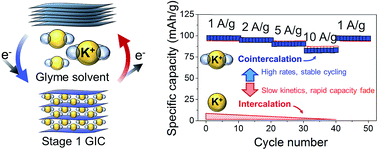Durable potassium ion battery electrodes from high-rate cointercalation into graphitic carbons†
Abstract
We report the first demonstration of potassium ion cointercalation into graphitic carbon electrodes including both natural graphite and multi-layered graphene in both diglyme and monoglyme based electrolytes. Contrary to conventional desolvation-based intercalation of potassium, we demonstrate excellent capacity retention of ∼80% at rates up to 10 A g−1 (30 second charge), with 95% capacity retention over 1000 cycles, and up to 100 mA h g−1 capacity. Raman and X-ray diffraction following 1000 cycles demonstrates no signature of defects, damage, or change to graphitic crystallinity compared to uncycled pristine materials that is attributed to weak ion–lattice interactions due to the solvated guest K ions. In situ Raman spectroscopy highlights the sequential formation of a stage 4, 3, 2, and 1 graphite intercalation compound (GIC) that occurs without the signature of dilute staging. In a charged stage 1 compound, we observe lattice expansion from 0.335 nm to 1.16 nm and measure the work function to be ∼3.4 eV. Overall, this system overcomes rate and durability bottlenecks that limit current K-ion battery electrodes, and gives promise to cointercalation for durable, fast, and low-cost storage systems.


 Please wait while we load your content...
Please wait while we load your content...